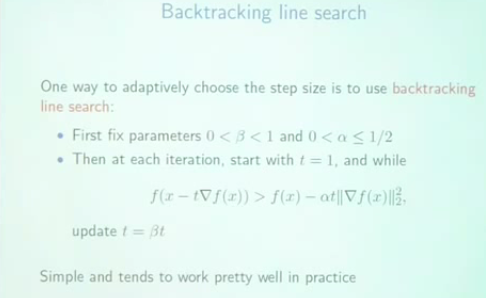一直以为梯度下降很简单的,结果最近发现我写的一个梯度下降特别慢,后来终于找到原因:step size的选择很关键,有一种叫backtracking line search的梯度下降法就非常高效,该算法描述见下图:

下面用一个简单的例子来展示,给一个无约束优化问题:
minimize y = (x-3)*(x-3)
下面是python代码,比较两种方法
# -*- coding: cp936 -*-
#optimization test, y = (x-3)^2
from matplotlib.pyplot import figure, hold, plot, show, xlabel, ylabel, legend
def f(x):
"The function we want to minimize"
return (x-3)**2
def f_grad(x):
"gradient of function f"
return 2*(x-3)
x = 0
y = f(x)
err = 1.0
maxIter = 300
curve = [y]
it = 0
step = 0.1
#下面展示的是我之前用的方法,看上去貌似还挺合理的,但是很慢
while err > 1e-4 and it < maxIter:
it += 1
gradient = f_grad(x)
new_x = x - gradient * step
new_y = f(new_x)
new_err = abs(new_y - y)
if new_y > y: #如果出现divergence的迹象,就减小step size
step *= 0.8
err, x, y = new_err, new_x, new_y
print 'err:', err, ', y:', y
curve.append(y)
print 'iterations: ', it
figure(); hold(True); plot(curve, 'r*-')
xlabel('iterations'); ylabel('objective function value')
#下面展示的是backtracking line search,速度很快
x = 0
y = f(x)
err = 1.0
alpha = 0.25
beta = 0.8
curve2 = [y]
it = 0
while err > 1e-4 and it < maxIter:
it += 1
gradient = f_grad(x)
step = 1.0
while f(x - step * gradient) > y - alpha * step * gradient**2:
step *= beta
x = x - step * gradient
new_y = f(x)
err = y - new_y
y = new_y
print 'err:', err, ', y:', y
curve2.append(y)
print 'iterations: ', it
plot(curve2, 'bo-')
legend(['gradient descent I used', 'backtracking line search'])
show()运行结果如下图:

孰优孰劣,一目了然
我的方法用了25次迭代,而backtracking line search只用了6次。(而且之前我用的方法不一定会收敛的,比如你把第一种方法的stepsize改成1,就会发现,没有收敛到最优解就停止了,这是一个bug,要注意)
这只是个toy example,在我真实使用的优化问题上,两者的效率差别更加显著,估计有10倍的样子